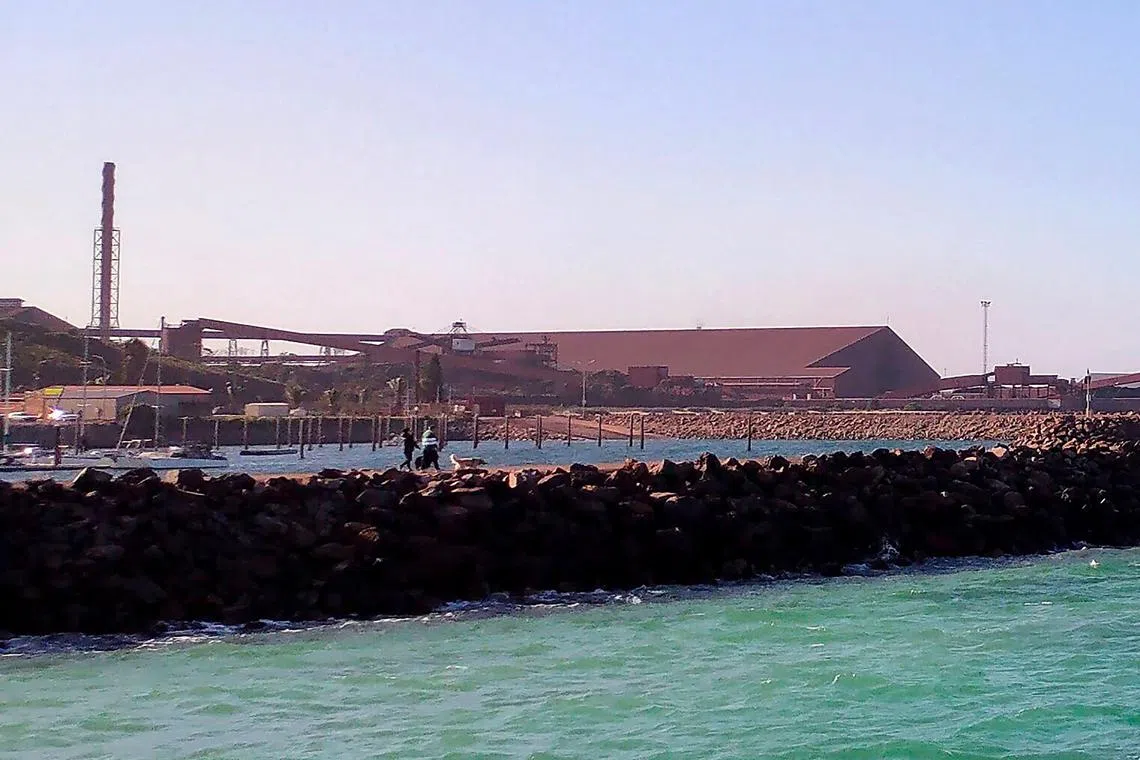Australia ends Indian tycoon’s ownership of steelworks as workers await new ‘saviour’
Sign up now: Get ST's newsletters delivered to your inbox

The 60-year-old Whyalla Steelworks has more than 1,000 employees and supports another 2,000 indirectly.
PHOTO: AFP
Follow topic:
SYDNEY - When he left school as a teenager, Mr Ryan Walsh, like many other residents in the remote South Australian town of Whyalla, followed in his father’s footsteps and took a job at the local steelworks.
Mr Walsh, an operator in the plant’s power and services department, has worked at the steelworks for 15 years and would like to stay.
“When I first started at the steelworks, it was the place to be. Everybody wanted to work there. There was a bit of pride when you worked,” the 34-year-old father of three told The Straits Times.
But Mr Walsh’s future, along with that of the entire town of 22,000 people, has been thrown into uncertainty due to the financial collapse of the Whyalla Steelworks.
The South Australian (SA) state government in February forced the plant into administration, ending its ownership by Gupta Family Group Alliance (GFG), the firm of Indian-born British steel tycoon Sanjeev Gupta. The SA government said it was concerned about the plant’s financial situation and the lack of investment in it.
Reflecting on the uncertain fate of the 60-year-old steelworks, which has more than 1,000 employees and supports another 2,000 indirectly, Mr Walsh said: “Life is on hold at the moment.”
He added: “It is hard to see the future when you have that little bit of cloud hanging over you.”
The twisting fate of the Whyalla steelworks reflects the changing nature of Australia’s economy and the broader turbulence that has roiled the global steel sector.
The massive plant produces 75 per cent of Australia’s structural steel and is only one of two remaining steelworks in Australia. The other, at Port Kembla, south of Sydney, is profitable, though revenue has varied in recent years as Chinese demand has fluctuated.
Declaring that “we need to make things here in Australia”, Australian Prime Minister Anthony Albanese on Feb 21 joined the SA government to invest A$2.4 billion (S$2.02 billion) to support the plant and keep it running until a new owner can be found.
“(The investment) will ensure that that community has a future,” he said.
The financial collapse of the plant marked a turnaround from the heady days of 2017, when Mr Gupta was greeted as a hero after stepping in to buy the steelworks for A$700 million, after it had gone into administration amid weak steel prices at the time.
Mr Gupta arrived with a “green steel” vision for the steelworks, planning to invest A$1 billion in building a vast solar plant and the world’s largest lithium-ion battery.
But this vision never materialised. The plant’s ageing blast furnace was due to be replaced by an electric-arc furnace, which would remove the need for coal. But the old furnace remained and had to be shut down in 2024, leaving the plant out of action for months.

Solar panels for the Whyalla solar plant project in South Australia in 2018.
PHOTO: ST FILE
The plant is currently operational and avoided layoffs due to the federal and SA governments’ injection of funds.
Another Whyalla resident, Mr Shane Karger, who worked at the steelworks until 2019 and now represents staff there as an organiser for the Australian Workers’ Union, said Mr Gupta had been greeted as “the future of Whyalla, the future of steelmaking”.
But hopes dimmed as GFG struggled to secure financing and was unable to invest in the plant.
“Things weren’t getting repaired properly and due to the furnace outages we didn’t make steel for 12 months,” he said.
“It was just deja vu. We were back to where we were before going into administration in 2016.”
The current administrators, KordaMentha, revealed on March 3 that the plant had A$1.3 billion in debts and had lost almost A$320 million in the seven months to February.
Mr Sebastian Hams, from KordaMentha, told ABC News that the state of the steelworks was “definitely worse” than when GFG bought it.
“It has been run down by a lack of investment so that is seriously problematic,” he said.
GFG said in a statement it was “saddened” about the decision to put it into administration. It said the furnace outage had put pressure on its working capital, but it had been hoping to secure funds before it was placed in administration.
Despite its failure to deliver its promised renewable energy projects or a new mill, a spokesman for the firm told The Australian it invested A$3.4 billion in the plant after “years of underinvestment by the previous owners and in the face of a weakening demand for global steel’’.
Mr Gupta’s office did not respond to requests by ST for an interview. His steel empire has struggled in recent years following the collapse in 2021 of financier Greensill Capital, which was a major lender to GFG.

The twisting fate of the Whyalla Steelworks reflects the changing nature of Australia’s economy and the broader turbulence that has roiled the global steel sector.
PHOTO: AFP
Professor John Quiggin, an economist from the University of Queensland, told ST that the SA and federal governments had made the correct decision to “see what can be salvaged rather than let it go under”.
He said the troubles the steelworks faced reflected the global struggle of steel plants in recent decades due to the massive increase in steel production in China, as well as falling demand due to the slowdown in Chinese construction.
“It is hard to say whether the problems that the Whyalla steelworks has are inherent in changes in the market or to do with Gupta, who has overextended himself in all sorts of ways,” he said.
In 2023, China produced 54 per cent of the world’s steel, up from 23 per cent of the global total in 2003.
The move by the federal and SA governments to help save the steelworks has largely been welcomed. The A$2.4 billion package includes A$100 million for immediate support to pay creditors and maintain the plant, plus A$384 million to ensure no jobs are lost while the steelworks is in administration.
But the federal government said the bulk of the funds – A$1.9 billion – will be used to support a new owner to upgrade the steelworks and help it to transition to a “green steel future”.
Mr Albanese’s decision to help save the plant comes as he faces an election due to be held by May and has won strong public support. A YouGov poll on Feb 28 found 62 per cent of Australians supported a government takeover of the steelworks and 9 per cent opposed, with 29 per cent unsure.
The SA Government said it expects an owner will be found in mid-2026.
Mr Walsh said recent years had been “exhausting” but he was hopeful that the government support could entice a buyer.
“That gives hope that there is a future ahead,” he said.
“I’ve learnt that when you get a good run, take it while you can… It is just a matter of time before you will have a down again.”


